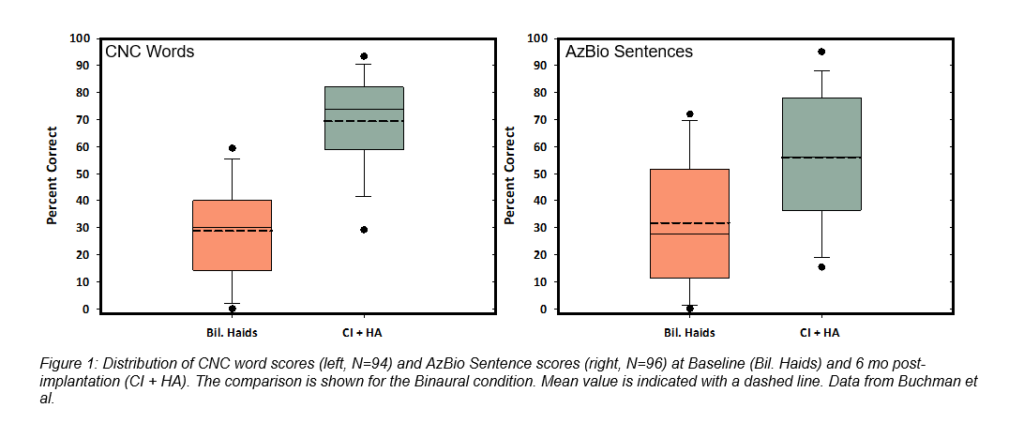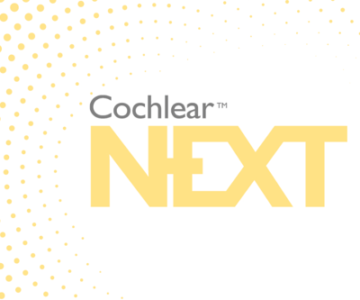Give your patients access to significantly better sound
Hearing in a noisy world remains one of the biggest challenges for cochlear implant recipients. Speech recognition nearly always involves listening in background noise, often with dynamic sources and different presentation levels.1
In a new real-world study, recipients found speech to be significantly clearer in everyday listening environments when they upgraded their current Cochlear™ SPrint™, ESPrit™, Freedom®, Nucleus® 5 or Nucleus 6 Sound Processor to the Nucleus 7 Sound Processor.2
Superior speech recognition benefits
In real-world acoustic environments, where competing dynamic noise originates from the sides and behind the listener, the Nucleus 7 Sound Processor with ForwardFocus† enabled, provided on average a 7.54 dB superior speech recognition benefit^ compared to the participants’ current sound processor, when used with their preferred program for listening in noise every day.2
Significant self-perceived benefits
The Speech, Spatial and Qualities of Hearing Scale3-5 (SSQ-12*) questionnaire self-perceived results showed that the Nucleus 7 Sound Processor provided significant benefit compared with the participants’ existing sound processors in their daily listening environments.2
Our most advanced sound processing technology
The Nucleus 7 Sound Processor features:
- SmartSound® iQ with SCAN using dual microphone technology, designed to help your patients automatically hear better in a range of challenging environments. ∞
- ForwardFocus is designed to reduce distracting noise from behind, making it easier for your patients to focus on face-to-face conversation. †
By accessing a next generation Nucleus 7 Sound Processor, your patients can benefit from advances in technology that help them enjoy clearer conversation, even in challenging and noisy listening environments.
To find out more about the patient benefits of upgrading to the Nucleus 7 Sound Processor, visit our website.
1 Hey M, Hocke T, Böhnke B, Mauger SJ. ForwardFocus with cochlear implant recipients in spatially separated and fluctuating competing signals – introduction of a reference metric. Int J Audiol. 2019;58(12):869-878.
2 Zhang J, Morgan C, Deng XC, Wang Y, Lee M. Hearing Performance Outcomes in Cochlear Implant Users after Nucleus® 7 Sound Processor Fitting. ACI Alliance Conference Poster. April 2021.
3 Gatehouse S, Noble W. The Speech, Spatial and Qualities of Hearing Scale (SSQ). Int J Audiol. 2004;43(2):85–99.
4 Noble W, Jen-sen NS, Naylor G, Bhullar N, Akeroyd MA. A short form of the Speech, Spatial and Qualities of Hearing scale suitable for clinical use: the SSQ12. Int J Audiol. 2013 Jun; 52(6): 409–412.
5 Liu J, Zhang J, Wang N, Li H, Fu X, Guo X, Fu L. Validation of the Chinese Translation of Speech, Spatial and Other Qualities of Hearing Scale for Parents. CN J. Otol. 2021; April In press. DOI: 10.3969 / j. issn. 1672-2922.2018
* Adults used Adult SSQ-12 and Children used P-SSQ-12. References 3-5.
^ Measured as a group mean SRT improvement.
† ForwardFocus can only be enabled by a hearing implant specialist. It should only be activated for users 12 years and older who are able to reliably provide feedback on sound quality and understand how to use the feature when moving to different or changing environments. It may be possible to have decreased speech understanding when using ForwardFocus in a quiet environment.
∞SNR-NR, WNR and SCAN are approved for use with any recipient ages 6 years and older who is able to 1) complete objective speech perception testing in quiet and in noise in order to determine and document performance 2) report a preference for different program settings.
In this study, Mandarin-speaking Chinese recipients were assessed using their current sound processor (ESPrit™, Sprint™, Freedom®, Nucleus 5 and Nucleus 6) then again after up to one-month use with the Nucleus 7 Sound Processor.












